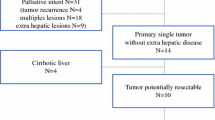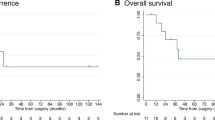Abstract
Objectives
To evaluate safety and effectiveness of selective internal radiation therapy (SIRT) using yttrium-90 for localized and locally advanced intrahepatic cholangiocarcinoma (iCCA).
Methods
A retrospective review was performed of patients with localized iCCA treated with SIRT at a single institution. Overall survival (OS), local tumor response, progression-free survival (PFS), and toxicity were collected. Stratified analysis was performed based on surgical resection. Predictor analysis of OS was performed using the Fine-Grey regression analysis model with patients bridged to surgery regarded as competing events.
Results
A total of 28 consecutive patients with localized iCCA were treated with a total of 38 sessions of SIRT (17 segmental, 13 lobar, and 8 combined deliveries) and a mean dominant target dose per session of 238.4 ± 130.0 Gy. The cumulative radiologic response rate was 16/28 (57.1%) with a median PFS of 265 days. Median survival time (MST) was 22.9 months for the entire cohort with 1-year and 3-year survival of 78.4% and 45.1%, respectively. Ten patients (34.5%) were downstaged to surgical intervention (7 resection, 3 transplant) and showed longer OS (p = 0.027). The 1-year and 3-year OS for patients who received surgery were 100% and 62.5% (95% CI: 14.2–89.3%), respectively. Age (p = 0.028), Eastern Cooperative Oncology Group performance status (p = 0.030), and objective radiologic response (p=0.014) are associated with OS. Two ≥grade 3 hyperbilirubinemia, anemia, and one pleuro-biliary fistula occurred post-SIRT.
Conclusions
SIRT for localized iCCA is safe and effective in achieving radiological response, downstaging to surgery and transplant, and resulting in pathologic necrosis.
Clinical relevance statement
Selective internal radiation therapy should be considered for patients with localized and locally advanced intrahepatic cholangiocarcinoma.
Key Points
• The effectiveness of radioembolization for intrahepatic cholangiocarcinoma (iCCA) can be underestimated given the inclusion of extrahepatic disease.
• Radioembolization is safe and effective for local and locally advanced iCCA. Age, Eastern Cooperative Oncology Group performance status, and radiologic response are associated with survival.
• Radioembolization should be considered for patients with localized and locally advanced iCCA.


Similar content being viewed by others
Abbreviations
- ALP:
-
Alkaline phosphatase
- ALT:
-
Alanine aminotransferase
- AST:
-
Aspartate aminotransferase
- CA 19-9:
-
Carbohydrate antigen 19-9
- CEA:
-
Carcinoembryonic antigen
- CI:
-
Confidence interval
- CR:
-
Complete response
- CT:
-
Computed tomography
- ECOG:
-
Eastern Cooperative Oncology Group
- iCCA:
-
Intrahepatic cholangiocarcinoma
- LDLT:
-
Living donor liver transplant
- MISPHEC:
-
The Yttrium-90 Microspheres in Cholangiocarcinoma trial
- mOS:
-
Median OS
- MRI:
-
Magnetic resonance imaging
- MST:
-
Median survival time
- NLR:
-
Neutrophil/lymphocyte ratio
- ORR:
-
Objective response rate
- OS:
-
Overall survival
- PD:
-
Progressive disease
- PR:
-
Partial response
- RECIST:
-
Response Evaluation Criteria in Solid Tumors
- SD:
-
Stable disease
- SHR:
-
Subdistribution hazard ratio
- SIRT:
-
Selective internal radiation therapy
- Y90:
-
Yttrium-90
References
El-Diwany R, Pawlik TM, Ejaz A (2019) Intrahepatic cholangiocarcinoma. Surg Oncol Clin. 28(4):587–599
Zhang X-F, Beal E, Bagante F et al (2018) Early versus late recurrence of intrahepatic cholangiocarcinoma after resection with curative intent. J Brit Surg. 105(7):848–856
Hewitt DB, Brown ZJ, Pawlik TM (2022) Surgical management of intrahepatic cholangiocarcinoma. Expert Rev Anticancer Ther. 22(1):27–38
Edeline J, Touchefeu Y, Guiu B et al (2020) Radioembolization plus chemotherapy for first-line treatment of locally advanced intrahepatic cholangiocarcinoma: a phase 2 clinical trial. JAMA Oncol. 6(1):51–59
Buettner S, Braat AJ, Margonis GA et al (2020) Yttrium-90 radioembolization in intrahepatic cholangiocarcinoma: a multicenter retrospective analysis. J Vasc Interv Radiol. 31(7):1035-1043. E2
Akinwande O, Shah V, Mills A et al (2017) Chemoembolization versus radioembolization for the treatment of unresectable intrahepatic cholangiocarcinoma in a single institution image-based efficacy and comparative toxicity. Hepat Oncol. 4(3):75–81
Mosconi C, Gramenzi A, Ascanio S et al (2016) Yttrium-90 radioembolization for unresectable/recurrent intrahepatic cholangiocarcinoma: a survival, efficacy and safety study. Br J Cancer. 115(3):297–302
Mouli S, Memon K, Baker T et al (2013) Yttrium-90 radioembolization for intrahepatic cholangiocarcinoma: safety, response, and survival analysis. J Vasc Interv Rad. 24(8):1227–1234
Yu Q, Liu C, Pillai A, Ahmed O (2021) Twenty years of radiation therapy of unresectable intrahepatic cholangiocarinoma: internal or external? a systematic review and meta-analysis. Liver Cancer 10(5):433–450. https://doi.org/10.1159/000516880
Ahmed O, Patel MV, Masrani A et al (2017) Assessing intra-arterial complications of planning and treatment angiograms for Y-90 radioembolization. Cardiovasc Int Radiol. 40(5):704–711
Badar W, Van (2020) Ha T, Zangan S, et al Yttrium-90 radioembolization therapy for combined hepatocellular and cholangiocarcinoma. Gastrointest Tumors. 7(4):144–150
Lüdemann W, Kahn J, Pustelnik D et al (2022) Yttrium-90 radioembolization for unresectable hepatocellular carcinoma: predictive modeling strategies to anticipate tumor response and improve patient selection. Eur Radiol 32(7):4687–4698. https://doi.org/10.1007/s00330-022-08585-x
Bagante F, Spolverato G, Merath K et al Maithel SK, Pulitano C, Bauer TW, Shen F, Poultsides GA, Soubrane O, Martel G, Koerkamp BG, Guglielmi A, Endo I, Pawlik TM (2019) Intrahepatic cholangiocarcinoma tumor burden: A classification and regression tree model to define prognostic groups after resection. Surgery 166(6):983–990. https://doi.org/10.1016/j.surg.2019.06.005
Gupta AN, Gordon AC, Gabr A, Kalyan A, Kircher SM, Mahalingam D, Mulcahy MF, Merkow RP, Yang AD, Bentrem DJ, Caicedo-Ramirez JC, Riaz A, Thornburg B, Desai K, Sato KT, Hohlastos ES, Kulik L, Benson AB, Salem R, Lewandowski RJ (2022) Yttrium-90 radioembolization of unresectable intrahepatic cholangiocarcinoma: long-term follow-up for a 136-patient cohort. Cardiovasc Intervent Radiol 45(8):1117–1128. https://doi.org/10.1007/s00270-022-03183-2
Xiao Y, Zheng X, Zhou C, Huang P, Wu F, Yang C, Zeng M (2023) Combined hepatocellular carcinoma-cholangiocarcinoma with a predominant HCC component: better survival and MRI-based prediction. Eur Radiol 33(2):1412–1421. https://doi.org/10.1007/s00330-022-09131-5
Sukato DC, Tohme S, Chalhoub D, Han K, Zajko A, Amesur N, Orons P, Marsh JW, Geller DA, Tsung A (2015) The prognostic role of neutrophil-to-lymphocyte ratio in patients with unresectable hepatocellular carcinoma treated with radioembolization. J Vasc Interv Radiol 26(6):816-824.e1. https://doi.org/10.1016/j.jvir.2015.01.038
Gupta AN, Gordon AC, Gabr A et al (2022) Yttrium-90 radioembolization of unresectable intrahepatic cholangiocarcinoma: long-term follow-up for a 136-patient cohort. CardioVasc Interv Radiol. 45(8):1117–1128
Paprottka KJ, Galiè F, Ingrisch M, et al Outcome and safety after 103 radioembolizations with yttrium-90 resin microspheres in 73 patients with unresectable intrahepatic cholangiocarcinoma—an evaluation of predictors. Cancers. 2021;13(21):5399.
Bargellini I, Mosconi C, Pizzi G et al (2020) Yttrium-90 radioembolization in unresectable intrahepatic cholangiocarcinoma: results of a multicenter retrospective study. Cardiovasc Interv Radiol. 43(9):1305–1314
Sarwar A, Ali A, Ljuboja D, Weinstein JL, Shenoy-Bhangle AS, Nasser IA, Morrow MK, Faintuch S, Curry MP, Bullock AJ, Ahmed M (2021) Neoadjuvant Yttrium-90 transarterial radioembolization with resin microspheres prescribed using the medical internal radiation dose model for intrahepatic cholangiocarcinoma. J Vasc Interv Radiol 32(11):1560–1568. https://doi.org/10.1016/j.jvir.2021.08.009
Rayar M, Sulpice L, Edeline J, Garin E, Levi Sandri GB, Meunier B, Boucher E, Boudjema K (2015) Intra-arterial Yttrium-90 radioembolization combined with systemic chemotherapy is a promising method for downstaging unresectable huge intrahepatic cholangiocarcinoma to surgical treatment. Ann Surg Oncol 22(9):3102–3108. https://doi.org/10.1245/s10434-014-4365-3
Sapisochin G, Ivanics T, Heimbach J (2022) Liver transplantation for intrahepatic cholangiocarcinoma: ready for prime time? Hepatology. 75(2):455–472
Beuzit L, Edeline J, Brun V, Ronot M, Guillygomarc’h A, Boudjema K, Gandon Y, Garin E, Rolland Y (2016) Comparison of Choi criteria and Response Evaluation Criteria in Solid Tumors (RECIST) for intrahepatic cholangiocarcinoma treated with glass-microspheres Yttrium-90 selective internal radiation therapy (SIRT). Eur J Radiol 85(8):1445–1452. https://doi.org/10.1016/j.ejrad.2016.05.020
Camacho JC, Kokabi N, Xing M, Schuster DM, Kim HS (2014) PET response criteria for solid tumors predict survival at three months after intra-arterial resin-based 90Yttrium radioembolization therapy for unresectable intrahepatic cholangiocarcinoma. Clin Nucl Med 39(11):944–950. https://doi.org/10.1097/RLU.0000000000000557
White J, Carolan-Rees G, Dale M et al (2019) Yttrium-90 transarterial radioembolization for chemotherapy-refractory intrahepatic cholangiocarcinoma: a prospective, observational study. J Vasc Interv Radiol. 30(8):1185–1192
Damm R, Seidensticker R, Ulrich G et al (2016) Y90 Radioembolization in chemo-refractory metastastic, liver dominant colorectal cancer patients: outcome assessment applying a predictive scoring system. BMC Cancer. 16(1):1–7
Oh D-Y, He AR, Qin S, Chen LT, Okusaka T, Vogel A, Kim JW, Suksombooncharoen T, Ah Lee M, Kitano M, Burris H, Bouattour, M, Tanasanvimon S, McNamara MG, Zaucha R, Avallone A, Tan B, Cundom J, Lee C-k, Takahashi H, Ikeda M, Chen J-S, Wang J, Makowsky M, Rokutanda N, He P, Kurland JF, Cohen G, Valle JW (2022) Durvalumab plus gemcitabine and cisplatin in advanced biliary tract cancer. NEJM Evid 1(8). https://doi.org/10.1056/EVIDoa2200015
Goyal L, Kongpetch S, Crolley VE, Bridgewater J (2021) Targeting FGFR inhibition in cholangiocarcinoma. Cancer Treat Rev 95:102170. https://doi.org/10.1016/j.ctrv.2021.102170
Funding
The authors state that this work has not received any funding.
Author information
Authors and Affiliations
Corresponding author
Ethics declarations
Guarantor
The scientific guarantor of this publication is Qian Yu.
Conflict of interest
The authors of this manuscript declare no relationships with any companies, whose products or services may be related to the subject matter of the article.
Statistics and biometry
One of the authors has significant statistical expertise.
Informed consent
Written informed consent was waived by the Institutional Review Board.
Ethical approval
Institutional Review Board approval was obtained (University of Chicago).
Study subjects or cohorts overlap
None.
Methodology
• Retrospective
• Observational study
• Performed at one institution
Additional information
Publisher's Note
Springer Nature remains neutral with regard to jurisdictional claims in published maps and institutional affiliations.
Supplementary Information
Below is the link to the electronic supplementary material.
Rights and permissions
Springer Nature or its licensor (e.g. a society or other partner) holds exclusive rights to this article under a publishing agreement with the author(s) or other rightsholder(s); author self-archiving of the accepted manuscript version of this article is solely governed by the terms of such publishing agreement and applicable law.
About this article
Cite this article
Yu, Q., Ungchusri, E., Pillai, A. et al. Selective internal radiation therapy using yttrium-90 microspheres for treatment of localized and locally advanced intrahepatic cholangiocarcinoma. Eur Radiol 34, 2374–2383 (2024). https://doi.org/10.1007/s00330-023-10203-3
Received:
Revised:
Accepted:
Published:
Issue Date:
DOI: https://doi.org/10.1007/s00330-023-10203-3




